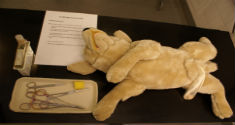The stuffed animal operating room laboratory allows students to train basic surgical skills on toys which resemble animals, featuring organs, veins and arteries. Measurements of students' heart rate, questionnaires and interviews show that after attending the 'teddy laboratory', students are less fearful about the possibility of surgery on living animals.
Rikke Langebæk, PhD and senior veterinary surgeon, said interviews of students have identified four aspects of the models which are important: The visual, the dimensional, the tactile and the situational aspect. On a four-point so-called Likert scale (poor/reasonable/good/really good), 75% of students rated the toy animal models as being 'good' or 'really good' for learning surgical procedures.

Funny to you, not to the bear. No one at the university seems concerned that veterinarians-in-training are too anxious to operate on dead animals but they will be just fine operating on live ones - if they use a toy first. Credit: University of Copenhagen
The skills laboratory opened in 2007, whereas previously the only chance veterinary students had of training simple surgical techniques was using dead animals which had been donated for teaching purposes. They say such training is not sufficient to alleviate the students' anxiety and sense of insecurity when subsequently having to operate on living animals. Apparently toy animals will be.
"In comparison with performing surgical procedures on dead animals or laboratory animals, we can see that the students feel more confident learning the basic surgical techniques using toy animals. Anxiety hampers learning so it is hardly surprising that the greater sense of confidence among students has resulted in them having a much easier time learning and remembering the surgical techniques," says Langebæk. "Also, we want to do everything in our power to reduce the use of laboratory animals for teaching purposes."
Even already dead ones.





Comments